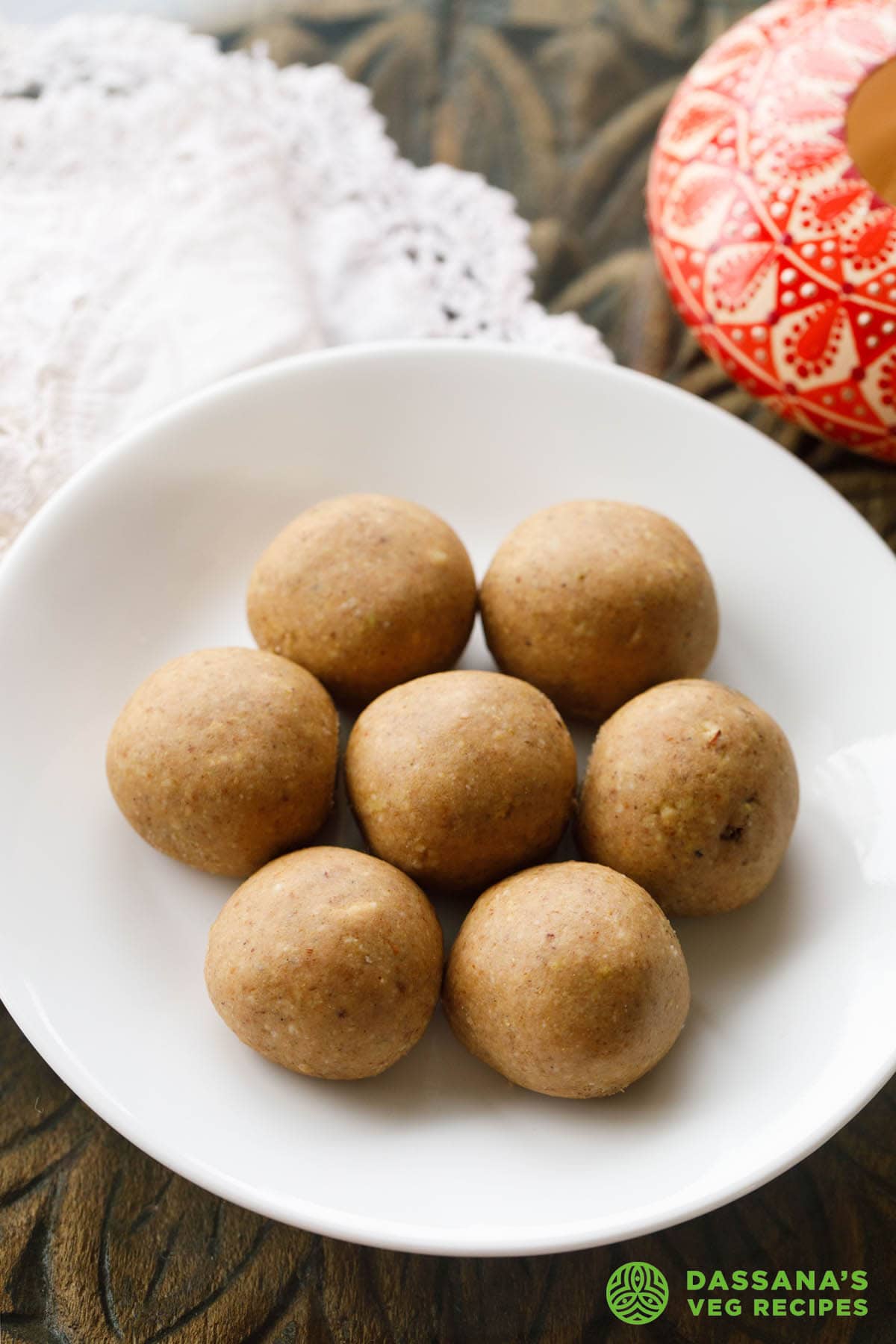Pinni Recipe
Written by Sneh Chaudhry on February 5, 2024

Pinni, a cherished winter delight in Punjabi cuisine, is a sweet made with basic ingredients like whole wheat flour, sugar, ghee, nuts, and flavorings. The round shape gives it its name.
Punjabi Pinni can be a relatively healthy treat when consumed in moderation. It includes nutritious ingredients like whole wheat flour, ghee, and various nuts, providing a source of energy and essential nutrients.
However, its calorie and sugar content should be considered. So, enjoying it as part of a balanced diet is key to maintaining a healthy lifestyle.
Ingredients
For Frying
- 3 tablespoons Ghee – preferably desi ghee
- 2 tablespoons/20 grams edible gum gond, optional
- 2 tablespoons/20 grams almonds or 20 almonds
- 2 to 3 tablespoons/20 grams cashews or 12 cashews
- 2 tablespoons/15 grams pistachios – shelled and unsalted
- 1 tablespoon/10 grams raisins
- ½ teaspoon green cardamom powder
- ½ teaspoon ginger powder (ground ginger)
More Ingredients
- 4 tablespoons Ghee – preferably desi ghee
- 1 cup/120 grams whole wheat flour
- 0.75 cup/75 grams powdered sugar or confectioner’s sugar, can also use castor sugar
Preparation
-
-
Heat 3 tablespoons of ghee in a frying pan or kadai (wok) over medium to medium-high heat.
-
-
-
Ensure ghee is about 170 to 180 degrees Celsius. To check, add a small piece of gond; it should puff up immediately.
-
When the ghee is moderately hot, add all gond pieces in the frying pan or kadai (wok)
-
Stir and fry until crispy, golden, and puffed. Keep stirring for even frying.
-
Use a slotted spoon to remove fried gond pieces. Place the fried gond pieces on kitchen paper towel and let them cool.
-
Reduce heat to low or medium-low.
-
Add almonds and fry for about a minute or until their color changes. Increase the heat to medium if needed. Remove fried almonds with a slotted spoon and set aside on kitchen paper towel.
-
-
Add cashews and fry for about 1 to 2 minutes or until light golden or golden. Increase the heat to medium if needed. Remove fried cashews and place on kitchen paper towel.
-
Add pistachios and fry for about a minute or until the color changes and light golden. Turn off the heat. Remove with a slotted spoon and place on kitchen paper towel.
Powdering Gond And Nuts
-
-
Let the fried gond and nuts cool at room temperature.
-
Once cooled, powder gond using a mixer-grinder, blender or other tools like a mortar-pestle or the back of a steel bowl or steel glass.
If using a mixer grinder, grind in short spurts or use the pulse option of your mixer grinder to get a fine texture. Remove powdered gond and set aside.
-
-
In the same grinder, pulse almonds, cashews, and pistachios to make a coarse or semi-fine mixture. Set aside. Opt to make a finely ground texture if you prefer.
-
Additionally, sift powdered sugar to remove lumps. Set aside.
Roasting Flour
-
Approximately half a tablespoon of ghee will be left in the pan or kadai after frying the nuts.
-
In the same kadai or pan, heat this remaining ghee until warm or lightly hot.
-
Add whole wheat flour. Mix it evenly with the ghee.
-
On medium-low to medium heat, roast flour for 8 to 10 minutes or until fragrant, stirring often and non-stop.
-
Once this is achieved, add 4 tablespoons of ghee and mix thoroughly with the roasted flour.
-
Stir continuously for 4 to 6 minutes or until the flour turns evenly golden.
-
The overall roasting duration for the flour typically ranges from 12 to 16 minutes, influenced by factors like flour texture, quality, pan thickness, and metal type.
Making Pinni
-
Turn off the heat. Place the pan or kadai on the kitchen countertop.
-
Add powdered gond, powdered nuts, raisins, sifted powdered sugar, green cardamom powder, and ginger powder. Mix thoroughly. Do a taste test and add more sugar if needed.
-
While still hot, take a portion of the mixture and form round pinnis.
Storage And Serving Suggestions
-
Store pinni at room temperature in an airtight container. Keeps well for about a month in the cold winters of North India.
-
Enjoy pinni as a sweet treat on their own or paired with hot milk, especially for children.
Notes
Customize Pinni
-
-
Flour Variety: Experiment with pearl millet, barley, sorghum, finger millet, semolina, gram flour (besan), urad dal flour or a mix for a unique Pinni flavor.
-
Sweetener Alternatives: Try palm sugar, coconut sugar, or jaggery, adjusting quantities based on your desired sweetness level.
-
-
Spice Infusion: Enhance your Pinni with cardamom, nutmeg, ginger or cinnamon for warmth and aroma.
-
Nut Choices: Opt for almonds, pistachios, cashews, or a mix to tailor the texture and flavor to your liking.
-
Coconut Twist: Add grated coconut or coconut powder for a tropical touch.
-
Seeds for Crunch: Introduce sesame seeds or poppy seeds for an extra crunch.
-
Dry Fruit Inclusions: Raisins, chopped figs, or dates bring natural sweetness and chewiness.
Recipe Notes
-
-
Ensure freshness and quality of ingredients, especially flour, ghee, and nuts.
-
Use desi ghee for an authentic, rich flavor.
-
-
You can opt to add edible gum (gond) or leave it out if you don’t have it.
-
Sift powdered sugar to eliminate lumps and ensure a smooth texture.
-
Modify the sugar amount according to your taste preference – feel free to reduce or increase. You may also use powdered white sugar or powdered raw sugar in the recipe.
-
Roast the flour slowly on medium-low to medium heat for even browning and a rich aroma. Consistently stir while roasting for uniform color and texture.
-
Adjust cooking time based on pan type, thickness, material, and size.
-
Taste the roasted flour mixture to ensure it is cooked without any raw mouthfeel.
-
Scale up the Pinni recipe for more servings as needed.







